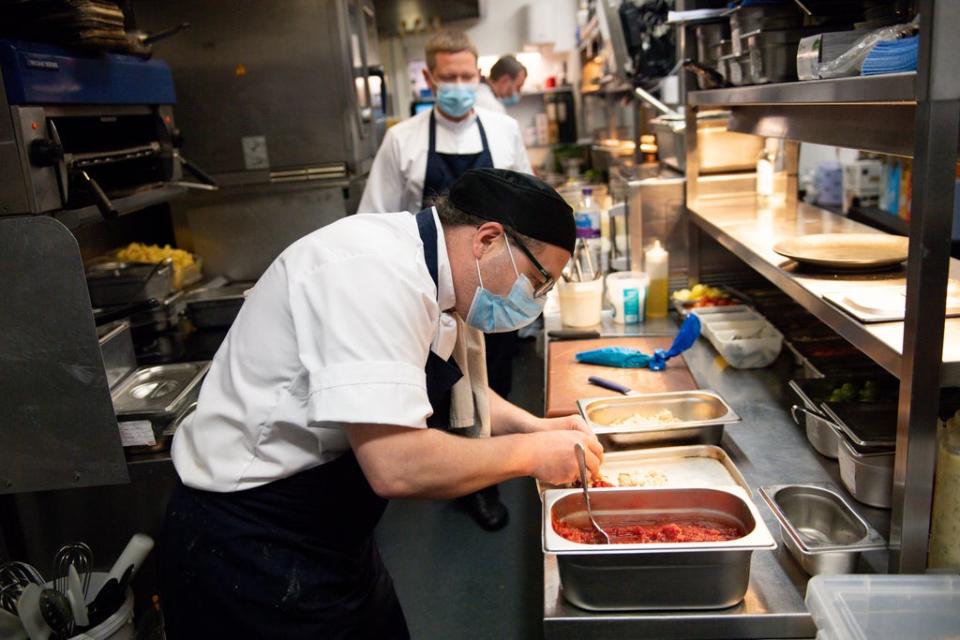Unemployment falls to 4.3% as companies take on more workers after furlough ends

Employers added 160,000 people to their payrolls in October as the UK labour market confounded fears that the end of the furlough scheme would result in a sharp rise in joblessness.
The extra staff took the total number of payrolled employees to 29.3 million in October, the Office for National Statistics reported.
The official unemployment rate for July to September – which includes data from before the end of the furlough scheme – fell to 4.3 per cent, down 0.5 percentage points compared with April to June. It remains 0.3 percentage points above its pre-pandemic level.
The latest monthly snapshot indicated the unemployment rate had fallen to 3.9 per cent in September, lower than before the pandemic, although monthly figures are more volatile and more likely to be revised later than quarterly ones.
On a quarterly basis, a record number of people flowed from unemployment to employment, underlining the success of the furlough programme, officially known as the coronavirus job retention scheme.
The number of vacancies rose 388,000 to a new record high of 1,172,000 as coronavirus restrictions were removed. Accommodation and food services saw the biggest jump, with the number of job postings up 79 per cent. Pubs, restaurants and hotels have struggled to find enough staff after an exodus of workers from hospitality since the first lockdown began.
More people are also quitting their jobs, the figures show. Total job-to-job moves across the whole economy increased to a record high of 979,000, largely driven by resignations rather than dismissals.
The figures will be welcomed by workers but add to problems for employers struggling to find staff amid an ongoing labour shortage that has hit businesses including retailers, hospitality and hauliers.
Sam Beckett, ONS head of economic statistics, said: “It might take a few months to see the full impact of furlough coming to an end, as people who lost their jobs at the end of September could still be receiving redundancy pay.
“However, October’s early estimate shows the number of people on the payroll rose strongly on the month and stands well above its pre-pandemic level.”
She added: “There is also no sign of an upturn in redundancies and businesses tell us that only a very small proportion of their previously furloughed staff have been laid off.”
Overall, the UK employment rate was estimated at 75.4 per cent between July and September – 1.1 percentage points lower than before the coronavirus pandemic, but 0.4 percentage points higher than the previous quarter (April to June 2021).
This was driven largely by a rise in economic inactivity – people out of work and not looking for a job – which is 0.9 percentage points higher than before the pandemic. More men than women moved from employment to inactivity. For both men and women, inactivity rose in the early months of the pandemic and has now begun to reverse, the ONS said.
Young people, who have seen their job prospects harmed more than other groups, began to see an improvement in the latest quarter. However, the employment rate for 16- to 24-year-olds remains 2.5 per cent down compared with December 2019 to February 2020.
The number of part-time workers picked up in the latest quarter but remains 6 per cent lower than before the pandemic.
Growth in regular pay (excluding bonuses) was 4.9 per cent among employees in July to September 2021. Real wages, adjusted for inflation and excluding bonuses, were up 3.1 per cent in a year. However, the ONS cautioned that the figures were flattered by being compared with a huge slump in earnings at the peak of the pandemic last year.
Since April, average inflation-adjusted pay has fallen as households have been hit by surging prices for essentials, notably gas, electricity and petrol.
“Today’s figures suggest workers will be waiting for some time for the pay surge the prime minister promised at the Conservative party conference,” said Frances O’Grady, general secretary of union umbrella organistion the TUC. “Real pay is less than £2 a week above the pre-2008 financial crisis peak.”
The government hailed the latest figures. Minister for employment Mims Davies said: “With over 100,000 young people landing roles through the Kickstart scheme, more people on payrolls this quarter in all corners of the country, and unemployment continuing to fall, it is clear our Plan for Jobs is working.”
Despite an improving jobs market, the UK economy remained 2.1 per cent smaller between July and September than it was before the pandemic, thanks to a more sluggish recovery than other wealthy nations in the G7.
The US economy has already surpassed its pre-pandemic level despite being hit hard by Covid-19. Its bounce back has been attributed partly to a $1.9 trillion programme of government spending to stimulate the economy. France and Germany have also recovered more strongly than the UK.
Laith Khalaf, head of investment analysis AJ Bell, warned that the labour shortage could further hamper the UK’s economic recovery.
“As we approach Christmas, it’s extremely positive news that unemployment is so low,” he said
“It’s less good news for employers that vacancies remain at record highs, which shows that many businesses are still struggling to attract staff as we approach the busy festive period.
“The rate of growth in vacancies has moderated slightly, but tens of thousands more jobs are being posted than filled, which suggests the economy is trying to move into top gear without enough fuel in the tank right now.”
Read More
Argentine midterms could make president a ‘lame duck’
‘Brutal’ time for hospitality as bars and restaurants close for lack of staff
Why US inflation is so high, and when it may ease
Ethnic minority unemployment 70% higher than white joblessness for past 20 years

 Yahoo Finance
Yahoo Finance 